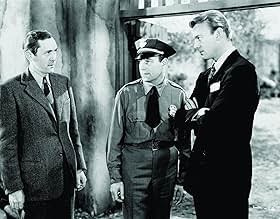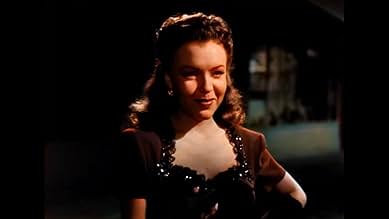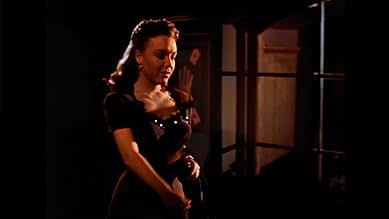VALUTAZIONE IMDb
6,7/10
6315
LA TUA VALUTAZIONE
Aggiungi una trama nella tua linguaA seemingly-tame leopard used for a publicity stunt escapes and kills a young girl, spreading panic throughout a sleepy New Mexico town.A seemingly-tame leopard used for a publicity stunt escapes and kills a young girl, spreading panic throughout a sleepy New Mexico town.A seemingly-tame leopard used for a publicity stunt escapes and kills a young girl, spreading panic throughout a sleepy New Mexico town.
- Regia
- Sceneggiatura
- Star
- Premi
- 2 candidature totali
Tuulikki Paananen
- Consuelo Contreras
- (as Tula Parma)
Ed Agresti
- Mexican Police Officer
- (non citato nei titoli originali)
Robert Andersen
- Dwight Brunton
- (non citato nei titoli originali)
Lulu Mae Bohrman
- Nightclub Patron
- (non citato nei titoli originali)
Jack Chefe
- Nightclub Waiter
- (non citato nei titoli originali)
David Cota
- Boy Singer
- (non citato nei titoli originali)
Sidney D'Albrook
- Waiter Serving Helene and Dwight
- (non citato nei titoli originali)
Rosita Delva
- Young Lover
- (non citato nei titoli originali)
Jacqueline deWit
- Helene
- (non citato nei titoli originali)
John Dilson
- Coroner
- (non citato nei titoli originali)
Recensioni in evidenza
A far better than average early film from the Val Lewton unit, The Leopard Man is as much murder mystery as horror picture. It is set in a New Mexico town where there are some weird goings on, including, among other things, big cat attacks. The photography is exceptional, moving from subjective to documentary-style objective without drastically altering the tone of the picture. What horror there is comes more from a sense of dread than anything that actually happens; also from the eerie feeling that certain places are unlucky, that some people are bound to die simply because of where they are. How true.
The star players are somewhat dull, but the supporting cast is quite good. And the merging and sometime colliding of the Anglo, Hispanic and Indian cultures is nicely presented. There is a sense of primitive feeling, of old religion, throughout the film, implied rather than stated, that is beyond the grasp of the hyper-rational lead players. We can catch this mood in fits and starts, but like the major characters, it eludes our grasp. Jacques Tourneur's direction is masterful every step of the way; and he uses music sensually yet emphatically, and the result is a fine-tuned film. It's major flaw is the revelation of the culprit, yet once Tourneur accepted the script's limitations he works superbly within them. The best thing about the movie is that its most crucial events happen mostly off-screen, leaving a good deal to our imaginations. And the minimalist script leaves a great deal in the dark, and even after the picture's florid, almost surreal climax, the air of mystery lingers. There are loose ends for sure, but Tourneur's polite, civilized touch dresses them up to appear profound and suggestive rather than threadbare, and the result is a pleasing conclusion that does not quite give the whole thing away; and we are left wanting to know just a little bit more. Tourneur was a true master.
The star players are somewhat dull, but the supporting cast is quite good. And the merging and sometime colliding of the Anglo, Hispanic and Indian cultures is nicely presented. There is a sense of primitive feeling, of old religion, throughout the film, implied rather than stated, that is beyond the grasp of the hyper-rational lead players. We can catch this mood in fits and starts, but like the major characters, it eludes our grasp. Jacques Tourneur's direction is masterful every step of the way; and he uses music sensually yet emphatically, and the result is a fine-tuned film. It's major flaw is the revelation of the culprit, yet once Tourneur accepted the script's limitations he works superbly within them. The best thing about the movie is that its most crucial events happen mostly off-screen, leaving a good deal to our imaginations. And the minimalist script leaves a great deal in the dark, and even after the picture's florid, almost surreal climax, the air of mystery lingers. There are loose ends for sure, but Tourneur's polite, civilized touch dresses them up to appear profound and suggestive rather than threadbare, and the result is a pleasing conclusion that does not quite give the whole thing away; and we are left wanting to know just a little bit more. Tourneur was a true master.
I think 'The Leopard Man' is the most memorable and frightening of the three Lewton-Tourneur collaborations. While it may be more straightforward than 'I Walked With a Zombie' or 'Cat People,' it's more atmospheric and more effective because its chills are predicated on agoraphobic horror. 'I Walked With a Zombie' was confined to a tropical island setting, while 'The Leopard Man' takes place in a New Mexico border town, on the edge of town, so that we travel along the desolate and wide open spaces of the sleepy Southwest at nighttime.
Early in the film, a young Mexican girl is sent on a late-night errand by her mother to buy some tortilla. Being that the shop is closed, she must traverse the sandy expanse between town and the nearest open shop. During this trek, she must pass under a bridge, and the shadows and sounds that stalk her are terrifying. Recalling this scene, right now, gives me goosebumps.
Horror is the most cinematic of all genres, because it works directly on the viewer's emotions and fears, using atmosphere, sound, and montage as its tools. Most horror films are either exploitative or slick and empty, unfortunately, but to watch 'The Leopard Man' is to encounter the full potential of the horror genre, as Tourneur paints with shadows and not entrails. Forgive its plot holes and its lunkheaded denouement, because the journey there is a hair-raising walk in the dark.
Early in the film, a young Mexican girl is sent on a late-night errand by her mother to buy some tortilla. Being that the shop is closed, she must traverse the sandy expanse between town and the nearest open shop. During this trek, she must pass under a bridge, and the shadows and sounds that stalk her are terrifying. Recalling this scene, right now, gives me goosebumps.
Horror is the most cinematic of all genres, because it works directly on the viewer's emotions and fears, using atmosphere, sound, and montage as its tools. Most horror films are either exploitative or slick and empty, unfortunately, but to watch 'The Leopard Man' is to encounter the full potential of the horror genre, as Tourneur paints with shadows and not entrails. Forgive its plot holes and its lunkheaded denouement, because the journey there is a hair-raising walk in the dark.
Jerry Manning (Dennis O'Keefe) decides to build some PR for his girlfriend's act by having her walk into the bistro where she performs with a black leopard on a leash. Her rival, Clo-Clo, retaliates by getting close to the leopard and clicking her castanets. The leopard is scared, pulls free of Kiki, and runs off.
Later that night, a girl coming home from the grocery store is mauled and killed by the leopard. Then two more mauling deaths occur - one a young girl, one a young woman. The leopard's owner, Charlie How-Come, says that he can't figure out why the leopard would kill the second and third victims rather than hide out away from the town. Manning agrees with him, and they search for the truth of what is happening in these maulings.
This film is full of brief but indelible little characterizations tangential to the storyline. There's so often an emphasis on the primitive, uncontrollable sides of our nature, that gives a deeper feeling to the sometimes over-busy plotting.
There's some strange characterization going on here too, For example, the first victim is a victim precisely because she has the world's worst mom. First she sends the girl out late at night to get groceries, and then when she returns, terrified because the leopard is after her, mom teases her and won't unlock the front door. Mom's mood and sense of urgency doesn't change until she hears the girl scream and sees her blood pool under the front door. And mom has the nerve to wear black at the funeral.
Later that night, a girl coming home from the grocery store is mauled and killed by the leopard. Then two more mauling deaths occur - one a young girl, one a young woman. The leopard's owner, Charlie How-Come, says that he can't figure out why the leopard would kill the second and third victims rather than hide out away from the town. Manning agrees with him, and they search for the truth of what is happening in these maulings.
This film is full of brief but indelible little characterizations tangential to the storyline. There's so often an emphasis on the primitive, uncontrollable sides of our nature, that gives a deeper feeling to the sometimes over-busy plotting.
There's some strange characterization going on here too, For example, the first victim is a victim precisely because she has the world's worst mom. First she sends the girl out late at night to get groceries, and then when she returns, terrified because the leopard is after her, mom teases her and won't unlock the front door. Mom's mood and sense of urgency doesn't change until she hears the girl scream and sees her blood pool under the front door. And mom has the nerve to wear black at the funeral.
After their success in 1942 with the fabulous 'Cat People', the star team of producer Val Lewton and director Jacques Tourneur would team up twice the year later. First for the compelling and brilliant 'I Walked With a Zombie', and second for this film; The Leopard Man. For the movie, the two filmmakers re-cast the star of their first success, the big black leopard, in this movie, who once again plays a big black leopard. The screenplay this time round makes far better use of the animal at the centre of the film, which allows the impressive creature to make a much bigger impression on the movie, and it also gives the film a unique edge over other horror movies, as there aren't a great deal that can build around a leopard. In fact, one thing that struck me about this movie was it's similarity to the 1980's remake of Cat People, and I wonder just how much influence that film took from this production. Anyway, the story here is deliriously simple and it follows a leopard that has escaped from a nightclub. After a few deaths, the cat is blamed...but is there more to this scenario than meets the eye?
Just like Val Lewton's earlier and later productions, The Leopard Man is notable for it's breathtaking atmosphere, which is once again up there with the greatest ever seen in cinema. The use of shadows and lighting is impressive, and when you combine this with Jacques Tourneur's incredible ability to stage a scene amidst this atmosphere; you've got a recipe for a truly great horror movie. This movie isn't as full of great scenes as Cat People was, but there is still some really good stuff on display, including my favourite scene which sees someone mauled behind a closed door. I'm not a big subscriber to the idea of 'less is more', but the scene I just mentioned goes to show just how well it can work if utilised properly. If the film had directly shown the killing, it would have uprooted the atmosphere and the terror of the movie on the whole wouldn't have been as astute. As it happens, The Leopard Man has got it spot on. But then again, would you expect anything less from a Val Lewton production?
Just like Val Lewton's earlier and later productions, The Leopard Man is notable for it's breathtaking atmosphere, which is once again up there with the greatest ever seen in cinema. The use of shadows and lighting is impressive, and when you combine this with Jacques Tourneur's incredible ability to stage a scene amidst this atmosphere; you've got a recipe for a truly great horror movie. This movie isn't as full of great scenes as Cat People was, but there is still some really good stuff on display, including my favourite scene which sees someone mauled behind a closed door. I'm not a big subscriber to the idea of 'less is more', but the scene I just mentioned goes to show just how well it can work if utilised properly. If the film had directly shown the killing, it would have uprooted the atmosphere and the terror of the movie on the whole wouldn't have been as astute. As it happens, The Leopard Man has got it spot on. But then again, would you expect anything less from a Val Lewton production?
Horror producer supreme Val Lewton teams up for the third and last time with director Jacques Tourneur to bring us The Leopard Man. Set in New Mexico, the story sees Jerry Manning (Dennis O'Keefe) hire a black leopard as a publicity stunt for his night-club performing partner, Kiki (Jean Brooks). Her rival, Clo Clo (Margo), is not impressed and promptly scares the animal into running away into the night. Pretty soon there is a panic looking as the cat appears to be mauling people to death. However, Manning & Kiki, driven by guilt, join the hunt for the rogue animal - but Manning is starting to believe the killings are not of the animal's doing...
Based on the book "Black Alibi" written by Cornell Woolrich, The Leopard Man's only crime is that it's not as great as its two predecessors, Cat People & I Walked With A Zombie. Rest assured, though, this is still a quality Lewton/Tourneur production. As a story it's simple and straight, with a running time of just over one hour keeping it lean and devoid of pointless waffle, but the piece positively thrives on its atmosphere - dealing as it does in murky shadows and unease inducing periods of silence. It also boasts a number of sequences that linger long in the memory, be it blood seeping under a door, the bend of a tree branch, or the dark under belly of a railway bridge, for such a short sharp shock of a movie there's so much to enjoy. The work of cinematographer Robert De Grasse (Vivacious Lady/The Body Snatcher) is top class and worthy of indulgence from the film noir loving crowd.
What you don't see is more effective on account of the eerie sense of dread that Messrs Lewton/Tourneur/De Grasse have built up. A fine film and proof positive that classic spookers could be made from relatively small budgets. 7/10
Based on the book "Black Alibi" written by Cornell Woolrich, The Leopard Man's only crime is that it's not as great as its two predecessors, Cat People & I Walked With A Zombie. Rest assured, though, this is still a quality Lewton/Tourneur production. As a story it's simple and straight, with a running time of just over one hour keeping it lean and devoid of pointless waffle, but the piece positively thrives on its atmosphere - dealing as it does in murky shadows and unease inducing periods of silence. It also boasts a number of sequences that linger long in the memory, be it blood seeping under a door, the bend of a tree branch, or the dark under belly of a railway bridge, for such a short sharp shock of a movie there's so much to enjoy. The work of cinematographer Robert De Grasse (Vivacious Lady/The Body Snatcher) is top class and worthy of indulgence from the film noir loving crowd.
What you don't see is more effective on account of the eerie sense of dread that Messrs Lewton/Tourneur/De Grasse have built up. A fine film and proof positive that classic spookers could be made from relatively small budgets. 7/10
Lo sapevi?
- BlooperAt the nightclub, Kiki is seated at a table with Jerry and Galbraith. As she asks Galbraith why he gave up teaching, a slim dark-haired woman wearing a matching suit and hat walks past their table. The shot cuts to Galbraith saying 'Various reasons', and the woman can be seen behind him (just over his shoulder on the far left of the screen), already seated at a nearby table.
- Citazioni
Charlie How-Come: You don't get the idea, mister. These cops banging those pans, flashing those lights, they're gonna scare that poor cat of mine. Cats are funny, mister. They don't want to hurt you, but if you scare them they go crazy. These cops, they don't know what they're doing.
- Versioni alternativeSome older TV prints of "The Leopard Man" run 59 minutes.
- ConnessioniFeatured in Terror on Twelve: The Leopard Man (1964)
- Colonne sonoreLas Mañanitas
(uncredited)
Traditional Mexican birthday song
Performed by Fely Franquelli and Ottola Nesmith
I più visti
Accedi per valutare e creare un elenco di titoli salvati per ottenere consigli personalizzati
Dettagli
- Tempo di esecuzione1 ora 6 minuti
- Colore
- Proporzioni
- 1.37 : 1
Contribuisci a questa pagina
Suggerisci una modifica o aggiungi i contenuti mancanti

Divario superiore
By what name was L'uomo leopardo (1943) officially released in India in English?
Rispondi































